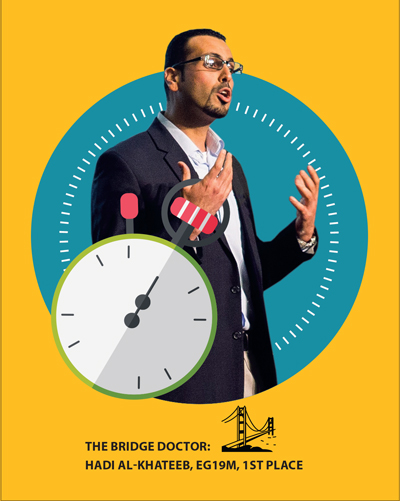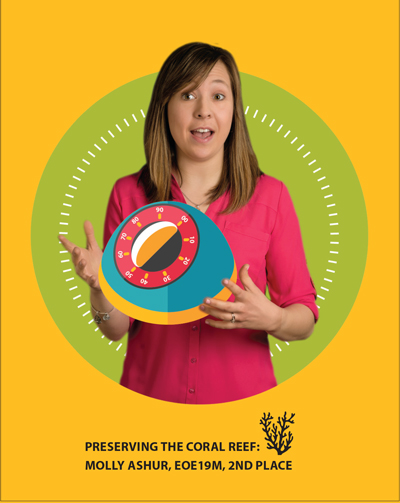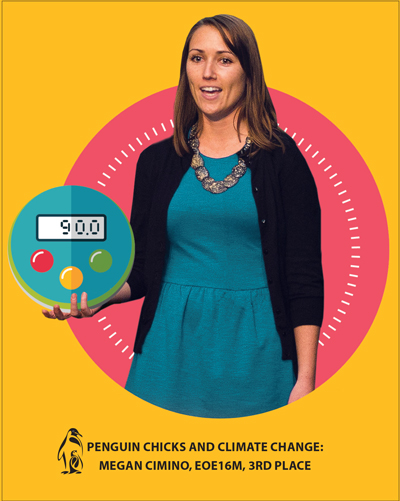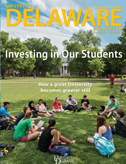
OUR STUDENTS | Quick! You have the next 90 seconds inside an elevator to tell the person standing next to you about your research. What do you say? Why does your research matter?
While few “elevator pitches” actually take place in elevators, there are numerous situations in which the ability to explain your research clearly, concisely and passionately will be important to your success.
That’s what the Pitch:90 competition aims to do. Sponsored by UD’s Delaware Environmental Institute and designed as an entertaining, fast-paced event, it provides students a chance to develop their communication and presentation skills while showcasing their research. Here, in their own words, the top-three winners of the most recent annual event share their pitches.

HADI AL-KHATEEB
“Do you get scared when you drive across a big bridge? Do you wonder if this bridge is going to collapse? Wouldn’t you feel better if knew that the bridge was hooked up to a health monitoring system? Yes, a health monitoring system. According to the American Society of Civil Engineers, one out of nine bridges in the United States is in urgent need of repair. [The] Federal Highway Administration estimates that it would cost $9 billion per year more than what we are currently spending to fix the problem. Sad situations like the collapse of the I-35 bridge in Minnesota in 2007 that killed 13 innocent people, and the traffic jam caused by the temporary closure of the I-495 bridge last year in Delaware, and many other incidents, have called into question our current bridge inspection methods. With a rapidly aging infrastructure, is it sufficient to rely on visual bridge inspections that are conducted once every two years? In my research, we combine new information technologies and advanced systems with bridge engineering to come up with ‘smart bridges.’ Utilizing the monitored data, the health of these bridges can be continuously monitored and inspected. By doing this, bridge owners and federal highway administrators can make sure that the bridges we drive on are not going to collapse, and also they can spend their limited funds on the most urgent problems. If my research is successfully implemented, I promise you, as a bridge doctor, that bridges will be safer, healthier and smarter. And you will not have to pay the extra $9 billion of taxes. Thank you.”

MOLLY ASHUR
“Close your eyes and picture a coral reef. I imagine you’re thinking of fish and turtles and sharks. But it is the corals themselves that are the true architects of the reef. Every summer, on the full moon of the hottest month of the year, most reef-building corals release their eggs and sperm into the water column in a spectacular mass spawning event. The fertilized eggs drift to the open ocean before returning to the reef to settle on the bottom. These larvae are only about the size of a freckle—no eyes, ears, nose or fins—yet miraculously many of them are able to successfully return to the reef. However, the oceans are changing drastically. You’ve all heard about climate change. Well, excess CO2 in the atmosphere can be incorporated into the ocean, changing the chemistry and altering the neural development of marine animals. For example, juvenile reef larvae—juvenile reef fish—after exposure to high CO2, can no longer tell the difference between the smell of the ocean and the smell of the reef. However, we know very little about the impacts on the sensory systems of corals. Therefore my research analyzes the sensory preferences, or “smelling ability,” of coral larvae after exposure to high CO2. If the larvae can no longer find their way back to the reef, the very foundation of the reef ecosystem begins to fail. So close your eyes again and picture a future reef. Not as pretty of a picture, right? Understanding the behavior of coral larvae after exposure to high CO2, and incorporating this into management practices, can help us to ensure the future of coral reefs.”

MEGAN CIMINO
“Have you guys heard of the latest celebrity weight-loss trend, where you stand in a freezer and shiver to burn off calories? I’m not kidding. People actually do this. And ironically, penguin chicks can lose weight in a really similar way. My research tries to understand the impacts of climate change on penguins, and Adélie penguins live in one of the most rapidly warming regions in the world. With warming air temperatures, there’s more moisture in the air and more snow and rain. Last year when I was down in Antarctica, I saw penguin chicks huddled together, shivering, on a rainy day. Penguin chicks are stuck on land, where they have no protection from the weather. They don’t have waterproof feathers, so if it rains or snow melts around their nest, their feathers can get wet. We found that wet and windy weather caused chicks to weigh less. So it’s like they’re standing in a freezer, while they’re wet, forcing them to burn off more calories to keep warm. A chick that doesn’t survive weighs only 4 percent less than a chick that does, which is about the weight of your iPhone—not very much. But to completely understand the effects of climate change on penguins, we have to study their whole life cycle. Some of my other research uses satellites and underwater robots to look at penguin breeding habitats and dive behaviors. The one thing we do know is that if wet conditions become more common, penguin chicks will continue to lose weight like celebrities.”



